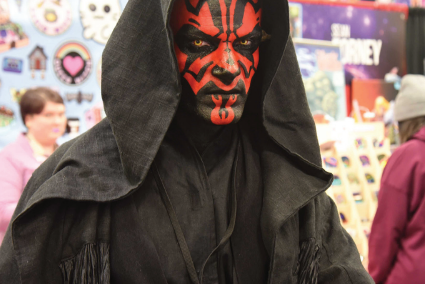This cosplayer is channeling the force. Photo Credit: Ismael David Mujahid
When you think of a creative industry that has only grown in prominence the last few years, comics are sure to be top of the list. Whether driven by the onslaught of TV and big screen adaptations or well-written and high-powered stories flying off shelves nationwide, from coast-to-coast graphic novels are definitely in vogue. But while its many fantastic characters are being shared, the men and women breathing life into the medium remain largely hidden from view.
Except, in most cases, when conventions come to town. Few are bigger or more personal than Galaxycon and it was in Columbus where comic aficionados like yours truly would meet their creative peers and learn how they too can make a difference in the world of comics.
In a distinguished career, Tony Isabella has a hand in some of the most important comic book characters. His most prominent creation so far is no doubt Jefferson Pierce aka Black Lightning, a character who recently graced our screens in a three-season run on the CW.
Related Article: Meet the Man Behind DC’s First Major Superhero of Color
“Don’t give up, don’t stop writing. You may have a hundred ideas you may not be happy with, but all it takes is one to get your name out there,” the creator of DC Comics’ first major African American superhero said.
The brains behind hundreds of comics was once a regular fan, just like the man dozens of people that mill about his booth at conventions. But his impact in changing the world of comics has been massive.
“At Marvel I worked on Luke Cage, created Misty Knight, and had the chance to develop Black Goliath. When I went to DC, I had the chance to create my own character from scratch, and that led to Black lightning,” Isabella said.
Don’t give up, don’t stop writing. You may have a hundred ideas you may not be happy with, but all it takes is one to get your name out there.
Tony Isabella
From the 70s till now, the affect of his writing has gone beyond the printed page as his effort to put heroes of color front row and center continues to inspire people today. But he was far from the only veteran creative with such a track record of success at the convention.
At an event full of heavyweight writers and editors, Dan DiDio stands out as a major creative force. His years of experience have seen him at the helm of DC Comics, where his creative vision helped make projects like the New 52 a reality. While the planning for those sorts of major events is extensive, when done right, they definitely leave a mark that makes people like Didio immensely proud.
DiDio’s credits include Phantom Stranger and Batman Incorporated Special. Photo Credit: Ismael David Mujahid
“’Infinite Crisis” and the “52” weekly series were really important for me,” he said when asked about his favorite past projects.
“We spent a lot of time planning for them and the fact that it went so smoothly, and people still talk about them to this day makes me really happy. So much time and effort were put into them.”
Both events would shake up the status quo of DC Comics and lead to the company’s resurgence.
Speaking about advice he’d give creatives today, DiDio said, “Look to the mediums, look at the types of stories you’re trying to sell and try to match the medium to your story. It’s not one size fits all anymore, you have to either be very specific about what you are creating and who you are creating it for and make sure you present and distribute it in a way that gets it to the audience you are trying to reach.”
Eisner-award winning artist Simon Bisley advised creatives to be “fearless.” It’s an approach that has served the revered artist of “Sláine” and “Joe Pineapples” well over the years.
Photo Credit: Mythos Editora
“Never give up. Part of it is persistence. Yes, there is luck involved but don’t ever think you don’t deserve success or that you don’t belong. And most of all, enjoy it!”
Freedom is what the artist cites as the reason he enjoyed working on “Lobo” in 1990 so much. Just a year later he would serve as the artist on “Batman/Judge Dredd: Judgment on Gotham”, which would earn him comic industry’s top prize for art.
Rodney Barnes knows a thing or two about being fearless and taking risks. The writer, showrunner, producer, and screenwriter has a shelf full of top prizes to prove it. And he hasn’t slowed down, with his writing duties for the Image Comics series “Killadelphia” earning him even more acclaim.
“Don’t just paint by the numbers, there’s something unique that everyone has to say based on their unique experience. Develop your voice as much as your writing skill,” said Barnes.
Marvel veteran Ann Nocenti called on writers ‘to just write.’ Answering an ad in the Village Voice brought her into the world of comic books for the first-time decades ago and the New Yorker hasn’t looked back since. A quick look at her career shows just how important innovation can be in sustaining one’s success.
Nocenti has written everything from Batman to the X-Men. Photo Credit: Ismael David Mujahid
“‘Seeds’ is my favorite,” she said reflecting on her favorite work. “Karen Berger, who founded Vertigo, later created Berger Books. There I’ve been able to make ‘Ruby Falls’ and ‘Seeds’. It is great doing something different, something that isn’t superhero related.”
Years from now, some of us could be saying the exact same thing. With fearlessness, persistence, our own voice, and the drive to write the possibilities, just as they are on a blank page, are endless.
Ismael David Mujahid, Executive Editor


